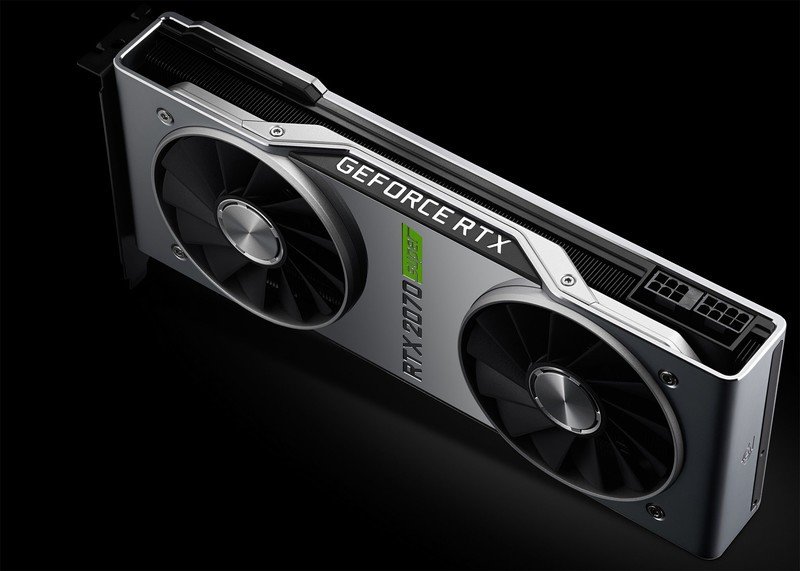NVIDIA GeForce RTX 2060 SUPER FE 8GB graphics card: when “Super” is not just marketing – On July 2, 2019, NVIDIA introduced two new video cards based on the Turing architecture GPU. They are GeForce RTX 2060 SUPER 8 GB and GeForce RTX 2070 SUPER 8 GB .
Many consider these models to be a response to the almost simultaneously released AMD Radeon RX 5700 and Radeon RX 5700 XT, however, in our opinion, NVIDIA always had such video cards in long-term plans, just when there was clarity about the competitors, the company shifted the deadlines and immediately responded. As a result, at the moment we have cheaper “old” GeForce RTX 2060 and RTX 2070 and faster SUPER-video cards for the same money.
In the future, we will try to test the GeForce RTX 2070 SUPER, but in today’s article, all attention will be paid to the reference version of the NVIDIA GeForce RTX 2060 SUPER Founders Edition, which received a very serious afterburner in comparison with the GeForce RTX 2060 in the form of additional streaming multiprocessors in the GPU, a noticeable increase in it frequencies and increasing the volume of video memory with its simultaneous transfer to a 256-bit bus.
Thus, the appearance of the word “SUPER” in the name of the model of the video card (yes, that’s it – in capital letters) is not only a marketing move, but also a very accurate description of the real performance increase. However, first things first.
1. Review of the video card NVIDIA GeForce RTX 2060 SUPER Founders Edition 8 GB
Specifications and Recommended Cost The
technical characteristics and cost of the NVIDIA GeForce RTX 2060 SUPER Founders Edition video card are shown in the table in comparison with the reference versions of the NVIDIA GeForce RTX 2070 FE and RTX 2060 FE.
Packaging and packaging
The design of the box in which the new NVIDIA GeForce RTX 2060 SUPER Founders Edition is supplied has undergone the most minimal changes: the inscription “SUPER” appeared in several places, and that’s it.
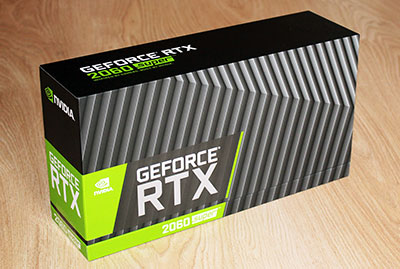

There are also no changes inside the box, and they were not required, since such packaging is quite reliable in terms of protecting the video card during transportation.
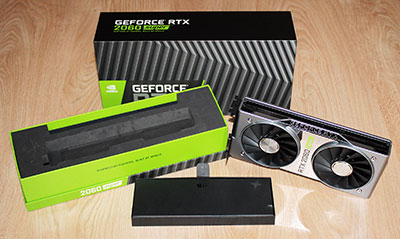
The package bundle of the reference version of the video card is similar to that of its predecessor: only two small instruction books.
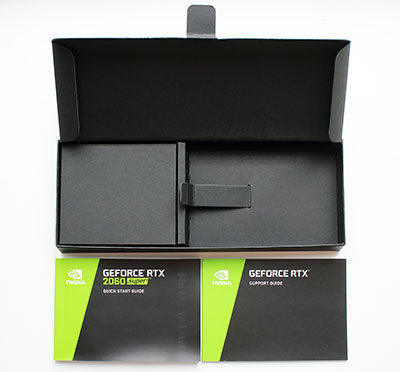
Note that for a limited period of time, when purchasing the reference versions of the GeForce RTX 2060 SUPER and GeForce RTX 2070 SUPER, you can get the keys to the latest Control and Wolfenstein: Youngblood games with support for real-time ray tracing as a bonus. The total cost of these games is $ 90, so this bonus looks very cool despite the fact that it is not physically included with the graphics card. The digital age 🙂
The Founders Edition we’re testing today is manufactured in China and comes with a 3-year proprietary warranty. Its recommended cost is 399 US dollars or 32,990 rubles. But they ask so much for the proprietary version of NVIDIA, while the original models of the company’s partners that have already appeared on sale can be found within 30 thousand rubles, and the usual GeForce RTX 2060 dropped in cost to 25 thousand rubles and below.
Design and features of the printed circuit board The dimensions and general design concept of the new reference video card have not changed in comparison with the NVIDIA GeForce RTX 2060: we have the same relatively compact video card with two cooling fans on the front side. She previously looked both laconic and attractive at the same time, I would even say sophisticated.
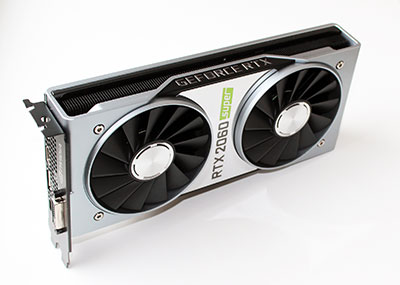
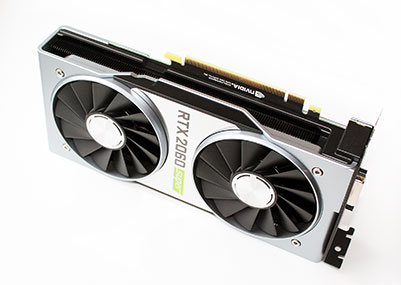
However, NVIDIA designers were able to make the video card even more sophisticated by replacing the black panel-insert between the fans with a gold one with a mirror polish and adding the word “SUPER” in the corporate green frame.
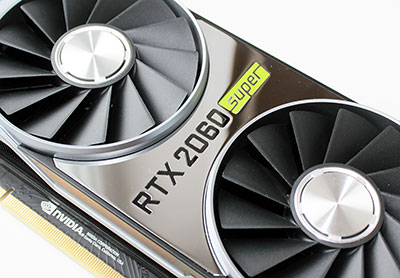
Now the video card looks even more beautiful and it is basically impossible to confuse it with a regular GeForce RTX 2060.
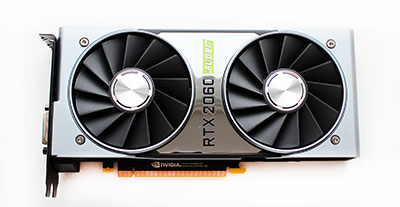
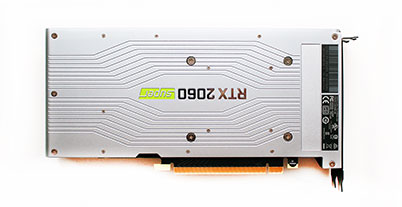
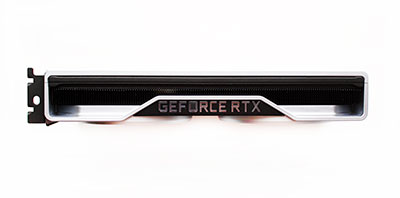
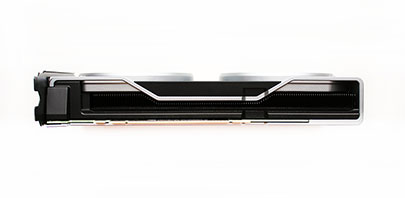
We add that the dimensions of the NVIDIA GeForce RTX 2060 SUPER Founders Edition are 231x103x38 mm, and it weighs 971 grams.
The two stickers on the back of the video card show the serial number and model number, as well as the country of manufacture.
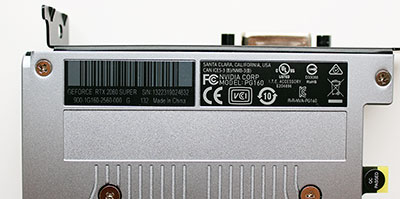
Below, on the “tail” of the PCI-E slot, there is a small sticker, where at first you might see the inscription “OC passed” and thoughts about a selected well-overclocked sample, but in fact it is “QC passed”, which means quality control has been carried out.
The set of video outputs has not changed: the video card has one DVI-D, one HDMI 2.0b and two DisplayPort 1.4a.
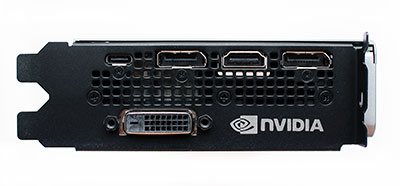
There is also a USB 3.1 Gen2 Type C (VirtualLink) port for connecting virtual reality devices.
An eight-pin power connector is removed from the opposite end of the video card.
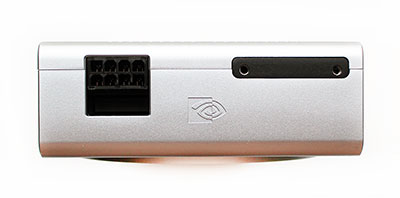
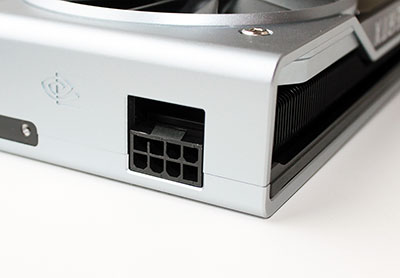
Compared to the regular GeForce RTX 2060, the maximum power consumption of the SUPER version has increased by 15 watts and is now 175 watts. The power supply unit for a system with one such video card (it is pointless to install two, they still do not support SLI) must be at least 550 watts.
We did not have the opportunity to disassemble the reference version of the NVIDIA GeForce RTX 2060 SUPER Founders Edition, but we managed to find out something about its printed circuit board. It is a copy of a short board of a regular GeForce RTX 2060.with a six-phase GPU power supply system and a uP9512 controller manufactured by uPI Semiconductor, but the SUPER version has 8 GB of memory, so there are no unsoldered microcircuits on the PCB.
Two more power phases are allocated for video memory and power circuits. By the way, the fact that NVIDIA originally used a printed circuit board in the GeForce RTX 2060 with a margin for additional power and memory confirms our assumption that SUPER versions of video cards have long been in the company’s release plans.
The GeForce RTX 2060 SUPER uses the same GPU as the regular RTX 2060 and RTX 2070 – the Turing TU106-A1 TU106-A1, manufactured in a 12nm process. However, now four streaming multiprocessors have been activated in it, as a result of which 256 unified shader processors have been added and their total number is now 2176 pieces. This is immediately 13.3% more than that of the GeForce RTX 2060, and only 5.6% less than that of the GeForce RTX 2070.
The number of texture units increased from 120 to 136, and ROP units – from 48 to 64. Simultaneously with this also increased the base frequency of the graphics processor – from 1365 to 1470 MHz. That is, the new SUPER video card has become as close as possible to the previous GeForce RTX 2070.
In addition to a noticeable increase in the GPU, the new GeForce RTX 2060 SUPER also accelerates video memory, the volume of which simultaneously increased from 6 GB to 8 GB. At the same effective frequency of 14 GHz, the width of the memory exchange bus was transferred from 192 to 256 bits and the bandwidth was increased from 336 to 448 GB / s, that is, by 33.3% at once .
If we recall that the GeForce GTX 1060 had a memory bandwidth of only 192.2 GB / s, then in comparison with the previous generation of video cards we are talking about an increase of 2.33times! We can say that we have definitely not seen such progress in the field of video cards for many years.
By the way, given the excellent overclocking potential of Micron’s GDDR6 microcircuits, NVIDIA could have safely increased its frequency by, say, 1 GHz, but, apparently, left this move for its flagship video cards. However, this fact is unlikely to upset overclockers.
We will provide the full specifications of the reference version of the GeForce RTX 2060 SUPER Founders Edition using the latest version of the GPU-Z utility.
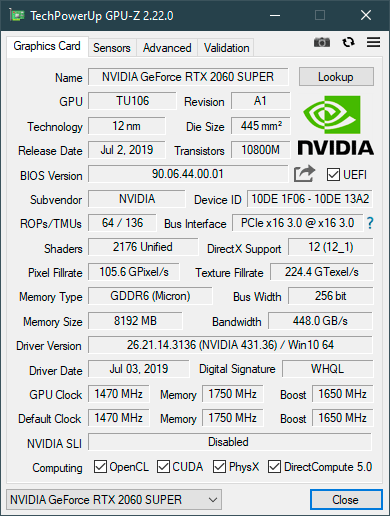
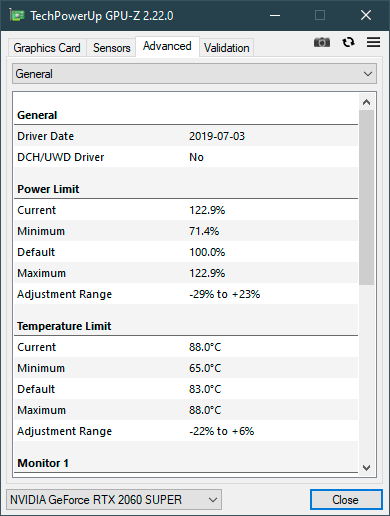
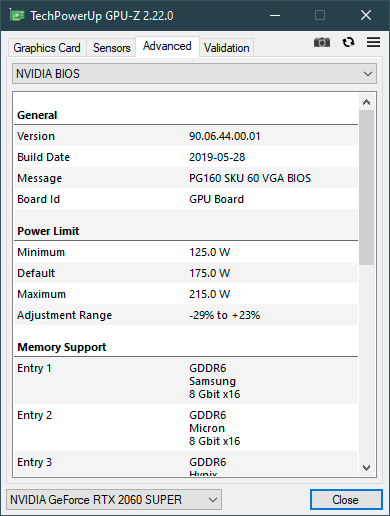
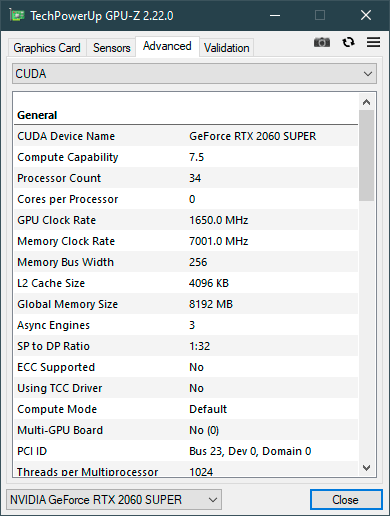
The BIOS of the video card is currently not readable by GPU-Z, we will add it to the article later. Cooling system Unlike the graphics processor of the video card and memory, the cooling system on the GeForce RTX 2060 SUPER Founders Edition has not undergone any changes.
Guided by the principle “they are not looking for good,” the developers did not change anything and left the cooler as it is: a massive aluminum radiator with an evaporation chamber above the GPU and a heat pipe, as well as a heat distribution plate on memory chips and VRM circuit elements are cooled by two fans with impeller diameters 85 mm. The impeller rotation speed is controlled using the pulse-width modulation method in the range from 1490 to 3740 rpm (according to monitoring data).
As we remember, such a system adequately coped with cooling a regular GeForce RTX 2060, including overclocking, but now the heat dissipation of the new SUPER video card has become higher, which means that the task for the same cooler is more serious. We used the Fire Strike Extreme stress test from the latest version of the 3DMark graphics package to test the temperature regime of the video card as a load.
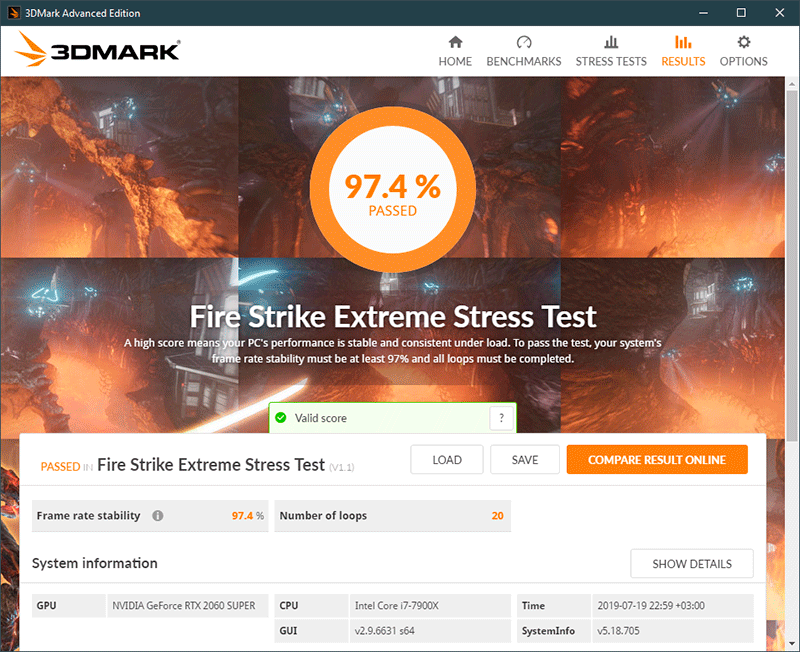
To monitor temperatures and all other parameters, we used MSI Afterburner version 4.6.1 and GPU-Z utility version 2.22.0. The tests were carried out in a closed case of the system unit , the configuration of which you can see in the next section of the article, at a room temperature of about 27 degrees Celsius.
First, we checked the temperature regime of the GeForce RTX 2060 SUPER Founders Edition with automatic fan speed control.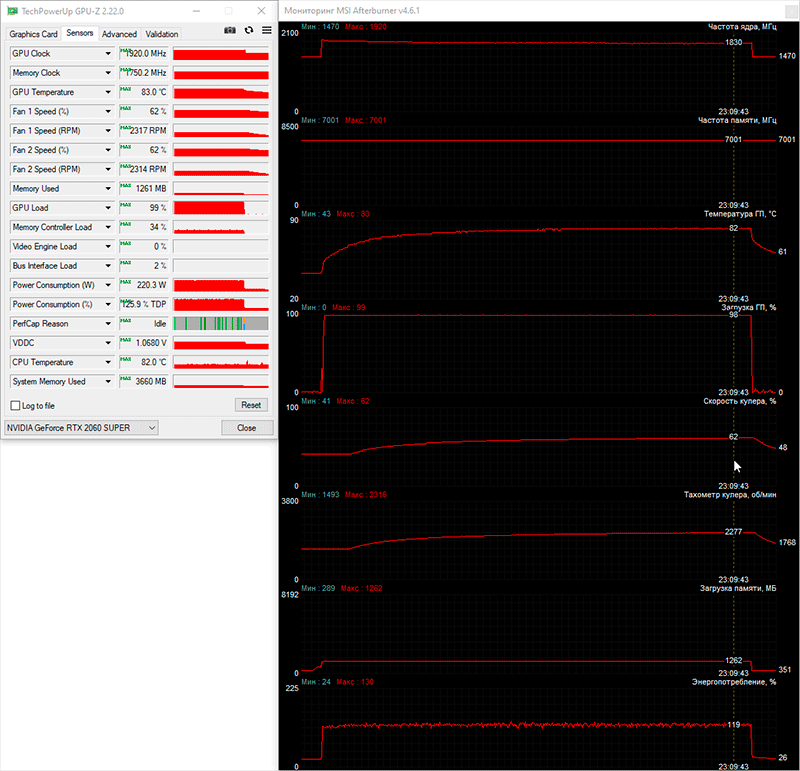
Automatic mode (1490 ~ 2310 rpm, 2 pcs.)
The temperature of the graphics processor of the video card has increased to 83 degrees Celsius, and the speed of the cooler fans has increased to 2310 rpm. These figures are indeed slightly higher than on a regular GeForce RTX 2060 with the same cooler (79 degrees Celsius and 2130 rpm, respectively), but the difference cannot be called critical. Here we note that the frequency of the GeForce RTX 2060 SUPER GPU stabilized at 1830 rpm – exactly the same value as that of the regular GeForce RTX 2060.
Now let’s look at the temperature mode of the reference video card at maximum fan speed.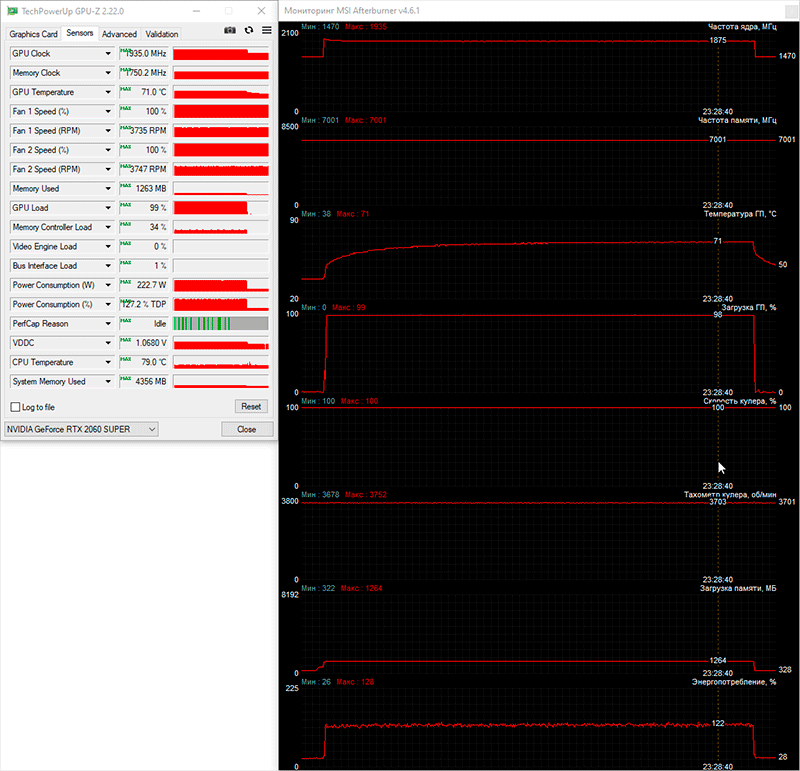
Maximum speed (~ 3700 rpm, 2 pcs.)
The maximum GPU temperature dropped immediately by 12 degrees Celsius, and the GPU frequency remained stable at 1875 MHz. Of course, the noise level of the video card in this mode was too high, but this test shows us that the original coolers from NVIDIA partner companies will not only be able to provide lower temperatures, but also have to keep the graphics processors at higher frequencies. Overclocking potential
At the time of writing, the scanner for automatic selection of the maximum GPU frequency in MSI Afterburner (by Alexey Nikolaychuk) was not working correctly, and version 4.6.2 beta 2 build 15658 was released after the tests were completed. Nevertheless, we will return to checking the automatic overclocking of a video card using the indispensable MSI Afterburner in the next articles, but for now, let’s check the overclocking potential of NVIDIA GeForce RTX 2060 SUPER Founders Edition in manual mode.
To overclock the video card, we increased the power and temperature limits to the maximum possible values and began to select the maximum frequency of the GPU without displaying image artifacts and other failures. The operating mode of the cooler fans did not change. The result of a two-hour test was +145 MHz (+ 9.9%) to the base frequency, which, in our opinion, is very good. In turn, the video memory in most tests was able to operate at a frequency exceeding the nominal 2100 MHz, but in especially resource-intensive benchmarks one could notice artifacts. Therefore, the overclocking frequency of the video memory had to be reduced to 1960 MHz or + 14%.
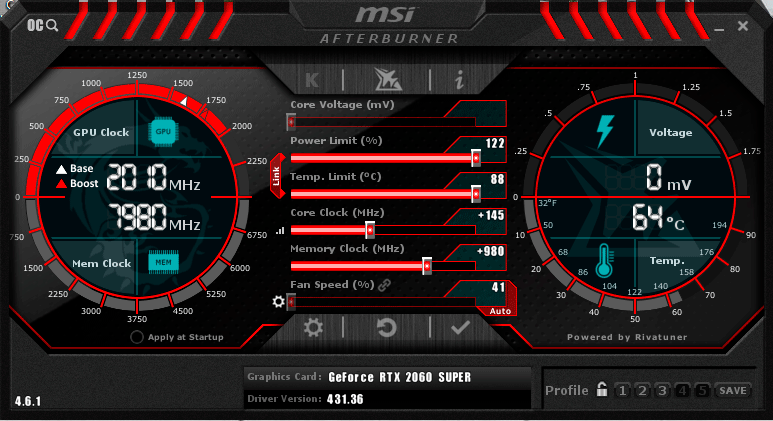
As a result, the frequencies of the overclocked video card were 1615-1795 / 15960 MHz .
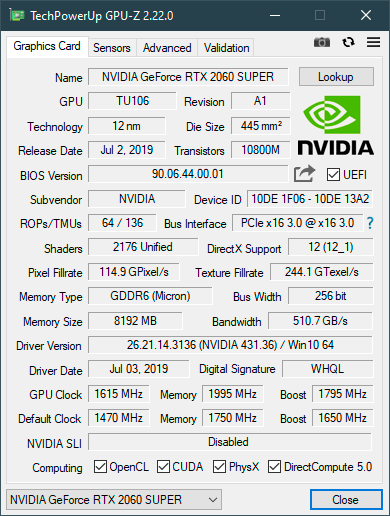
Recall that when overclocking the reference version of the GeForce RTX 2060, we managed to reach frequencies of 1510-1825 / 15784 MHz. That is, if the base frequency on the old version of the RTX 2060 was lower, then the forced one is even higher, and according to the monitoring data of the overclocked GeForce RTX 2060 SUPER, it operates at almost the same frequencies as the overclocked GeForce RTX 2060 .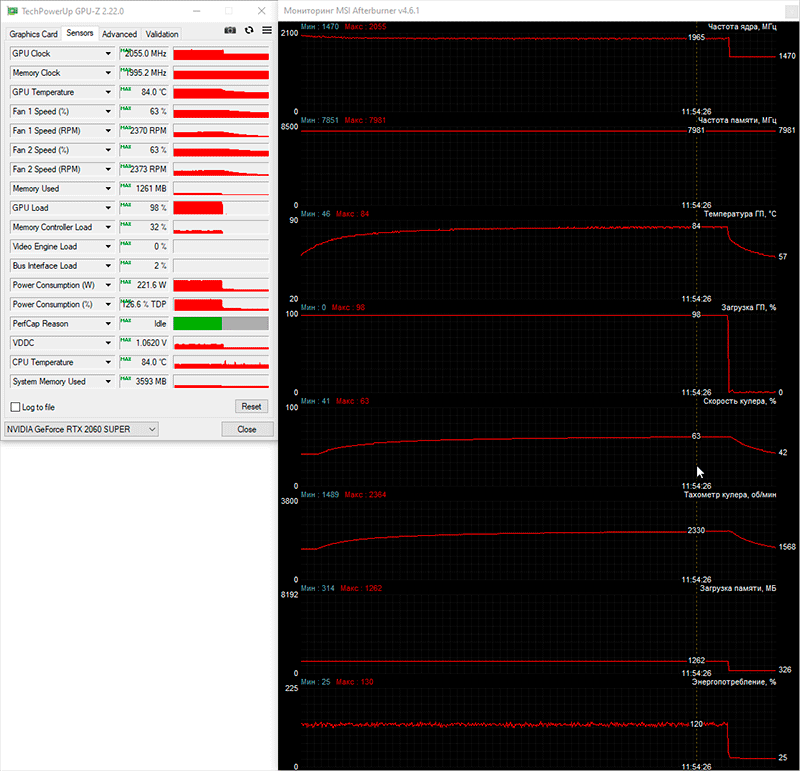
Automatic mode (1490-2370 rpm, 2 pcs.)
The temperature of the graphics processor of the overclocked video card has increased by one degree Celsius in comparison with the nominal operating mode, and the maximum speed of the cooler fans with automatic adjustment has increased by only 60 rpm.
2. Test configuration, tools and testing methodology
The video cards were tested in a closed system case on the following hardware configuration:
motherboard: ASRock X299 OC Formula (Intel X299 Express, LGA2066, BIOS P1.60 from 01.11.2018);
central processor: Intel Core i9-7900X 3.3-4.5 GHz (Skylake-X, 14 nm, U0, 10×1024 KB L2, 13.75 MB L3, TDP 140 W);
CPU cooling system: Phanteks PH-TC14PЕ (2 x Corsair AF140, 760 ~ 1090 rpm);
thermal interface: ARCTIC MX-4 (8.5 W / (m • K);
RAM: DDR4 4×4 GB Corsair Vengeance LPX 2800 MHz (CMK16GX4M4A2800C16) (XMP 2800 MHz / 16-18-18-36_2T / 1.2 V or 3000 MHz / 16-18-18-36_2T / 1.35 V);
video cards:
– NVIDIA GeForce RTX 2080 Founders Edition 8 GB / 256 bit, 1515-1800 (1965) / 14000 MHz;
– Gigabyte GeForce RTX 2070 SUPER Gaming OC 8 GB / 256 bit, 1605-1815 (1965) / 14000 MHz;
– NVIDIA GeForce RTX 2060 SUPER Founders Edition 8 GB / 256 bit, 1470-1650 (1830) / 14000 MHz and overclocked to 1615-1795 (1965) / 15960 MHz;
– NVIDIA GeForce RTX 2060 Founders Edition 6 GB / 192 bit, 1365-1680 (1830) / 14000 MHz;
– NVIDIA GeForce GTX 1070 Ti 8 GB / 256 bit 1607-1683 (1823) / 8008 MHz;
drives:
– for the system and benchmarks: Intel SSD 730 480 GB (SATA III, BIOS vL2010400);
– for games and benchmarks: Western Digital VelociRaptor 300 GB (SATA II, 10,000 rpm, 16 MB, NCQ);
– archived: Samsung Ecogreen F4 HD204UI 2 TB (SATA II, 5400 rpm, 32 MB, NCQ);
sound card: Auzen X-Fi HomeTheater HD;
case: Thermaltake Core X71 (six be quiet! Silent Wings 2 [BL063] at 900 rpm: three for blowing in, three for blowing out);
control and monitoring panel: Zalman ZM-MFC3;
PSU: Corsair AX1500i Digital ATX (1.5 kW, 80 Plus Titanium), 140 mm fan;
monitor: 27-inch Samsung S27A850D (DisplayPort, 2560×1440, 60 Hz).
To reduce the dependence of the performance of video cards on the platform speed, a 14-nm ten-core processor with a multiplier of 44, a reference frequency of 100 MHz and the Load-Line Calibration function activated at the highest level, was overclocked to 4.4 GHz when the voltage in the motherboard BIOS was raised to 1.119 V.
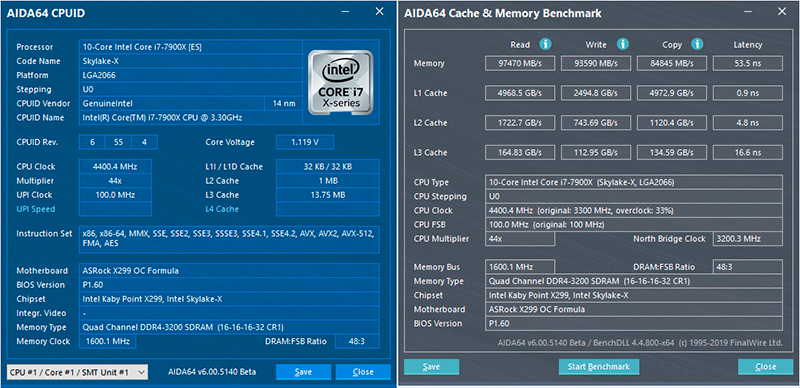
In turn, 16 gigabytes of DDR4 RAM operated in four-channel mode at 3.2 GHz with main timings 15-16-16-32 CR1 at 1.35 V and adjusting individual secondary timings.
The maximum level of performance in today’s article will again set the NVIDIA GeForce RTX 2080 Founders Edition, and we will directly compare the new product with the NVIDIA GeForce RTX 2060 Founders Edition.
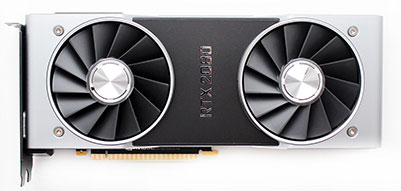
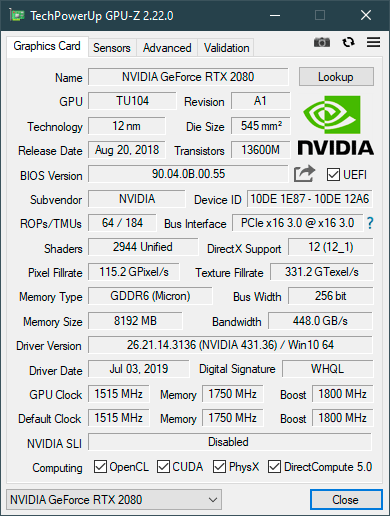
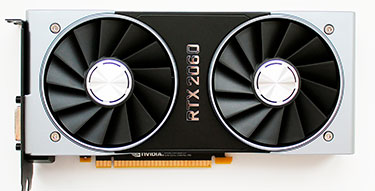
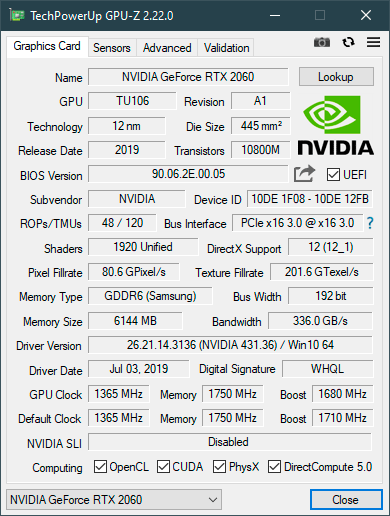
In addition, it will certainly not be superfluous to compare the GeForce RTX 2060 SUPER with the new GeForce RTX 2070 SUPER, presented in today’s test by the original model Gigabyte GeForce RTX 2070 SUPER Gaming OC, and from the previous generation video cards we included NVIDIA GeForce GTX 1070 Ti at nominal frequencies …
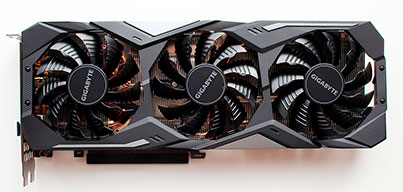
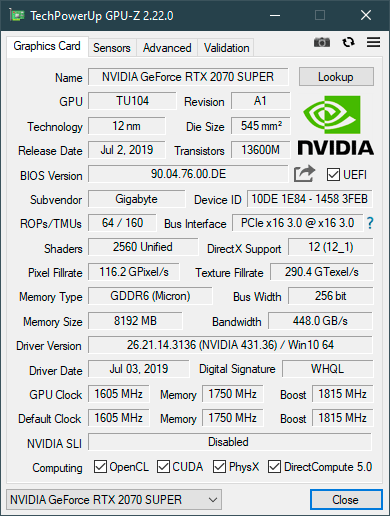
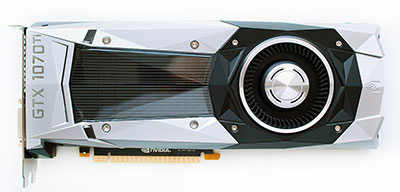
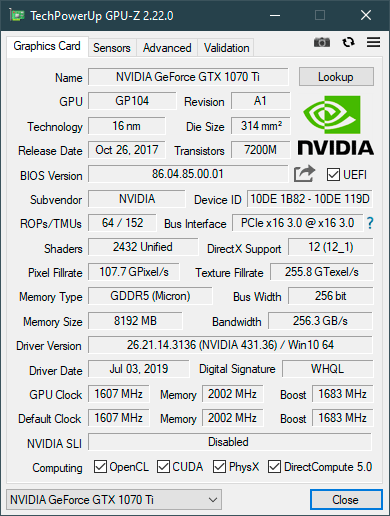
Let us add that the power and temperature limits on all video cards were increased to the maximum possible, and in the GeForce drivers, instead of optimal power consumption, the priority was set to maximum performance. Unfortunately, graphics cards based on AMD GPUs are again missing in today’s testing, but we are working in this direction.
Testing, which began on July 19, 2019, was carried out under the operating system Microsoft Windows 10 Pro 1903 with all updates as of the specified date and with the installation of the following drivers:
motherboard chipset Intel Chipset Drivers – 10.1.18019.8144 WHQL dated 05/03/2019 ;
Intel Management Engine Interface (MEI) – 1923.12.0.1278 WHQL from 06/20/2019;
drivers for video cards on NVIDIA GPUs – GeForce 431.36 WHQL from 07/09/2019 .
In today’s testing, we only used 2560×1440 pixels. Two graphics quality modes were used for the tests: “Quality + AF16x” – the quality of textures in the drivers by default with anisotropic filtering at 16x and “Quality + AF16x + MSAA 4x” with anisotropic filtering at 16x and full-screen anti-aliasing using the MSAA algorithm of degree 4x … In some games, due to the specifics of their game engines, other anti-aliasing algorithms were used, which will be indicated later in the methodology. Anisotropic filtering and full-screen anti-aliasing was enabled in the game settings. If these settings were absent in games, then the parameters were changed in the control panel of the GeForce drivers. V-Sync was also forcibly disabled there. In addition to the above,
The video cards have been tested in two graphics tests and fifteen games, updated to the latest versions as of the date of the publication. In comparison with our previous article on video cards, the list of games has changed again. We excluded Middle-earth: Shadow of War and F1 2018 from it. The first one is already relatively old and insufficiently resource-intensive for new video cards, and the second was replaced with the new F1 2019. In addition, the recently released Total War: Three Kingdoms was included in the testing from new games. … Now the current list of test applications is as follows (games and further test results in them are arranged in the order of their official release): 3DMark
(DirectX 9/11/12) – version 2.9.6631, tested in the scenes Fire Strike Extreme, Fire Strike Ultra, Time Spy Extreme and Port Royale (graphical score is shown on the diagram); Unigine Superposition (DirectX 11) – version 1.0, tested in 1080P High, 1080P Extreme and 4K Optimized settings; Deus Ex: Mankind Divided (DirectX 12) – version 1.19 build 801.0, all quality settings are manually set to the maximum level, tessellation and depth of field are activated, at least two consecutive runs of the benchmark built into the game; For honor
(DirectX 11) – version 70.113, maximum graphics quality settings, volumetric lighting – MHBAO, dynamic reflections and blur effect enabled, anti-aliasing oversampling disabled, tests without anti-aliasing and with TAA, double sequential run of the benchmark built into the game; Tom Clancy’s Ghost Recon Wildlands (DirectX 12) – version 1.6.0, graphics quality settings to maximum or Ultra-level, all options are activated, tests without anti-aliasing and with SMAA + FXAA, double sequential run of the benchmark built into the game; Warhammer 40,000: Dawn of War III
(DirectX 11) – version 4.0.0.19122, all graphics quality settings to the maximum level, anti-aliasing is activated, but in AA mode, resolution scaling up to 150% was used, a double sequential run of the benchmark built into the game; Call of Duty: WWII (DirectX 11) – version 1.24.01, all graphics quality settings at the extra level, shadows are enabled, testing without anti-aliasing and when the SMAA T2X option is activated, a double run of the opening scene of the first stage of D-Day was used, FRAPS 105 seconds; Strange Brigade (DirectX 12) – version 1.47.22.14, setting level “Ultra”, all quality improvement techniques are activated, asynchronous computation is enabled, two consecutive test cycles of the built-in benchmark without anti-aliasing and with its activation; Shadow of the tomb raider
(DirectX 12) – version 1.0 build 292, all parameters to the “Ultra” level, Ambient Occlusion – HBAO +, tessellation and other quality improvement techniques are activated, two cycles of the built-in benchmark test without anti-aliasing and with SMAA4x activation; Assassin’s Creed Odyssey (DirectX 11) – version 1.51, the built-in game benchmark was used with the Ultra High settings profile and disabled dynamic resolution, double test run without anti-aliasing and with anti-aliasing at the High level; HITMAN 2 (DirectX 12) – version 2.40.0, built-in test at “Ultra” detail level, SSAO enabled, shadow quality “Ultra”, memory protection disabled, test scene – “Miami”; Metro exodus
(DirectX 12) – version 0.1.0.17, built-in performance benchmark, Ultra and RTX settings profiles, double sequential test scene; Far Cry New Dawn (DirectX 12) – version 1.0.2, all settings to the maximum quality level – Ultra and High, motion blur enabled, built-in performance test without anti-aliasing and with TAA enabled; Tom Clancy’s The Division 2 (DirectX 12) – version 1.0.4, frame limit disabled, all settings set to the maximum quality level, resolution of projected textures – 512, built-in performance test; World War Z (DirectX 11) – version 1.21, FPS limitation disabled, all settings to Ultra, built-in performance benchmark without anti-aliasing and with TAA enabled;
Total War: Three Kingdoms (DirectX 11) – version 1.1.0, maximum graphics quality, shadow detail and squad size at Extreme level, built-in performance benchmark without anti-aliasing and with TAA activation; F1 2019 (DirectX 12) – version 1.06, the built-in game test was used on the Albert Park track in Australia in clear weather, the graphics quality settings were set to the maximum level for all points, the SSRT shadows were activated, the test was without anti-aliasing and with TAA.
Let’s add that if the games have implemented the ability to fix the minimum number of frames per second, then it was also shown in the diagrams. Each test was carried out twice, the best of the two obtained values was taken as the final result, but only if the difference between them did not exceed 1%. If the deviations of the benchmark runs exceeded 1%, then the testing was repeated at least one more time to get a reliable result.
3. Results of performance tests
3DMark
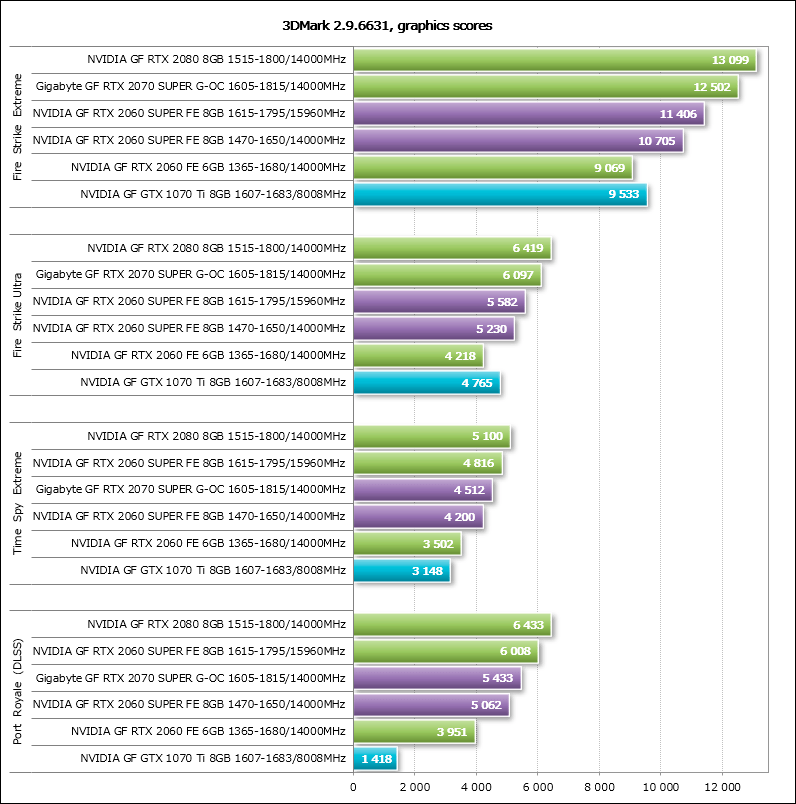
Unigine Superposition
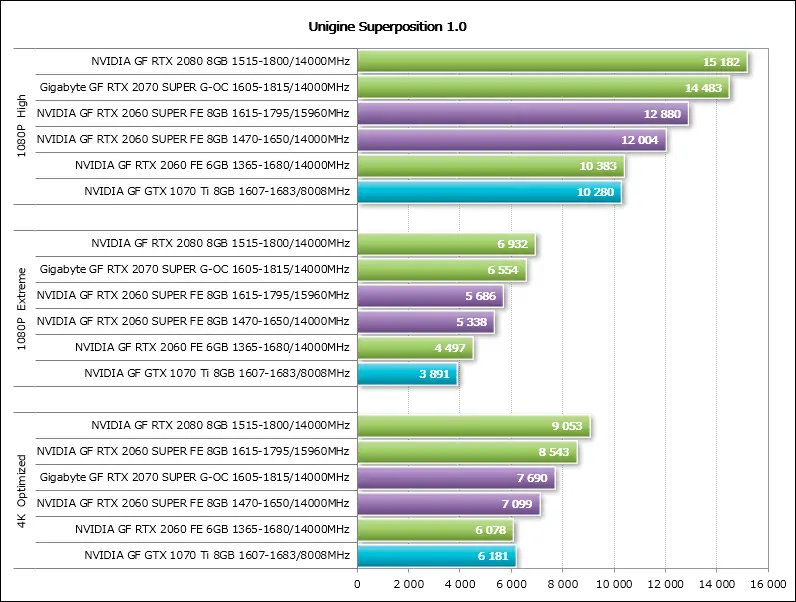
Deus Ex: Mankind Divided
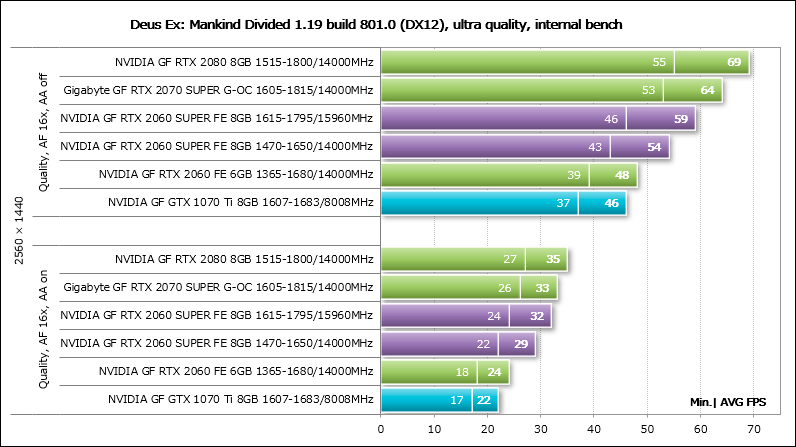
For Honor
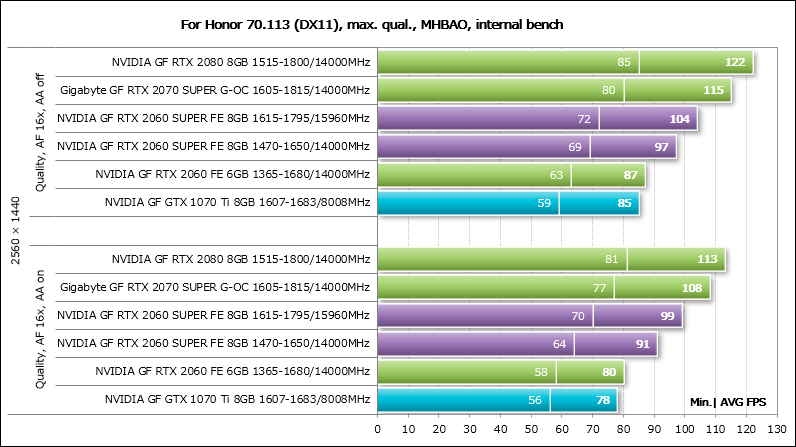
Tom Clancy’s Ghost Recon Wildlands
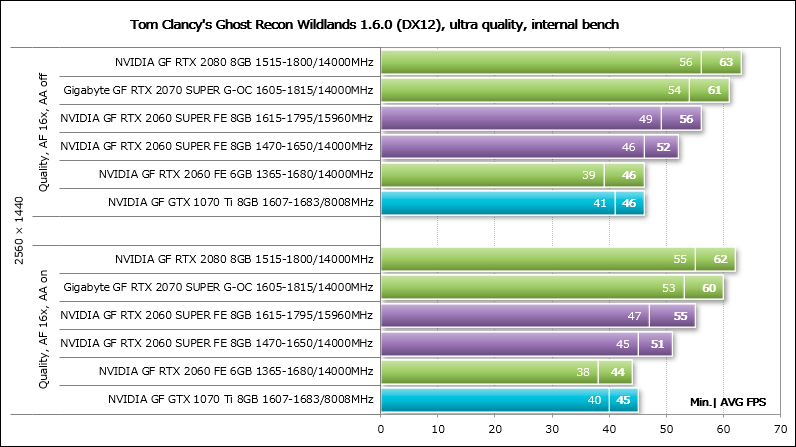
Warhammer 40,000: Dawn of War III
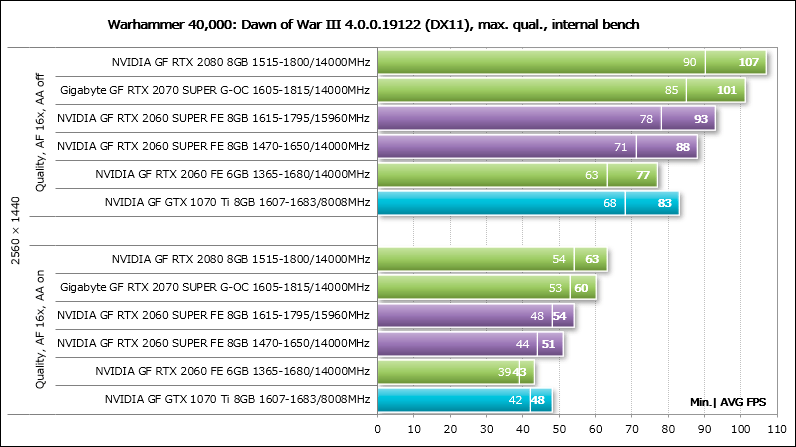
Call of Duty: WWII
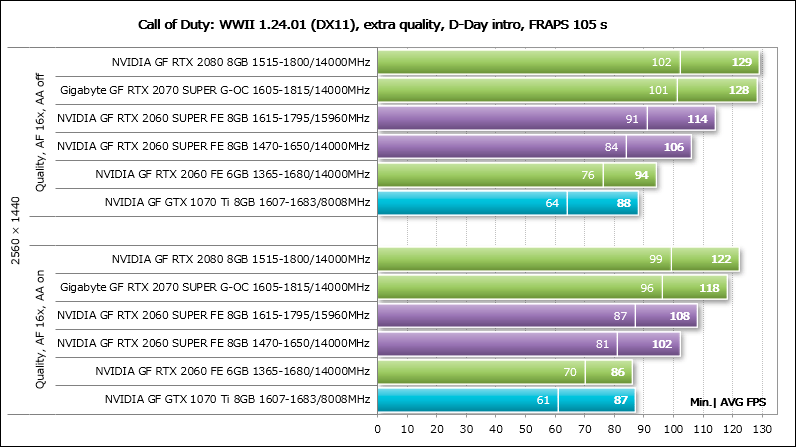
Strange Brigade
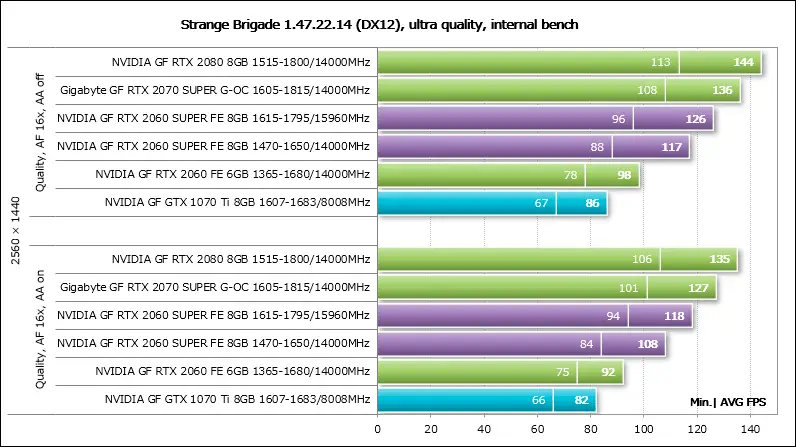
Shadow of the Tomb Raider
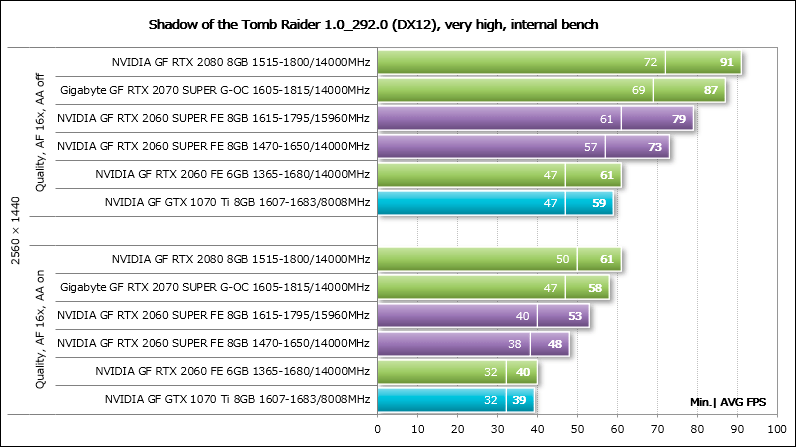
Assassin’s Creed Odyssey
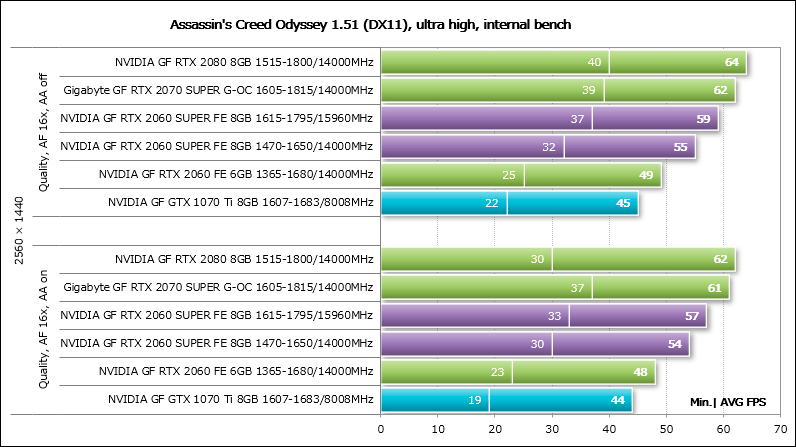
HITMAN 2
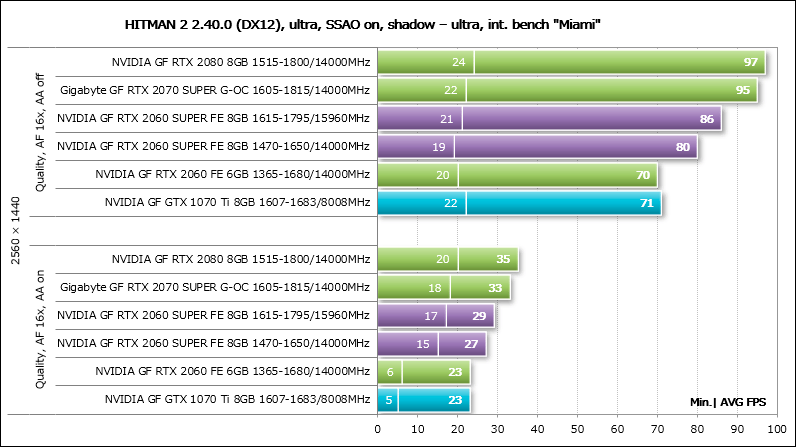
Metro Exodus
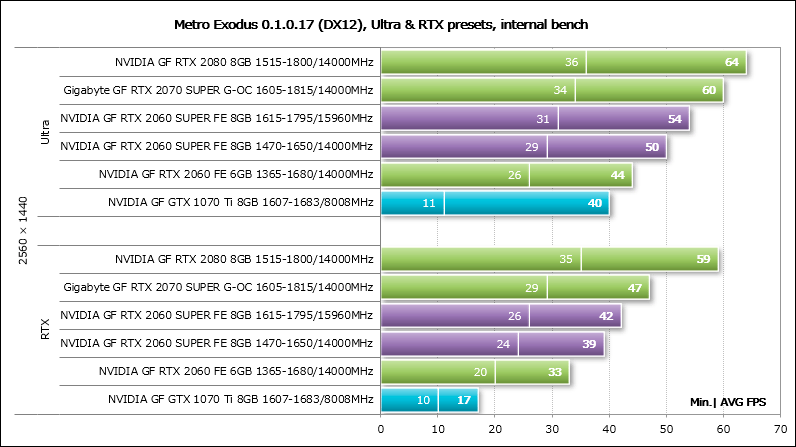
Far Cry New Dawn
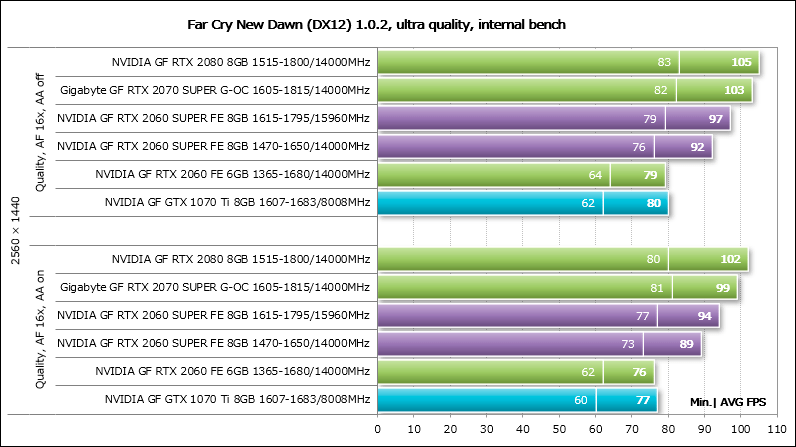
Tom Clancy’s The Division 2
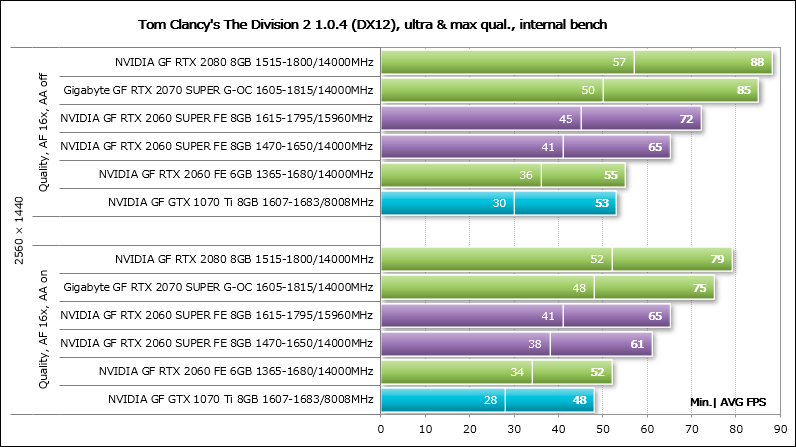
World War Z
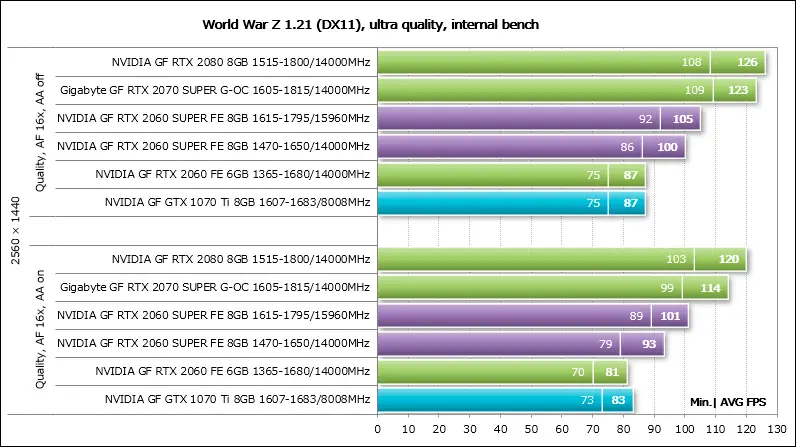
Total War: Three Kingdoms
Since we are testing this new game for the first time, we first present the graphics settings that were used for the tests and will be used in the following articles.
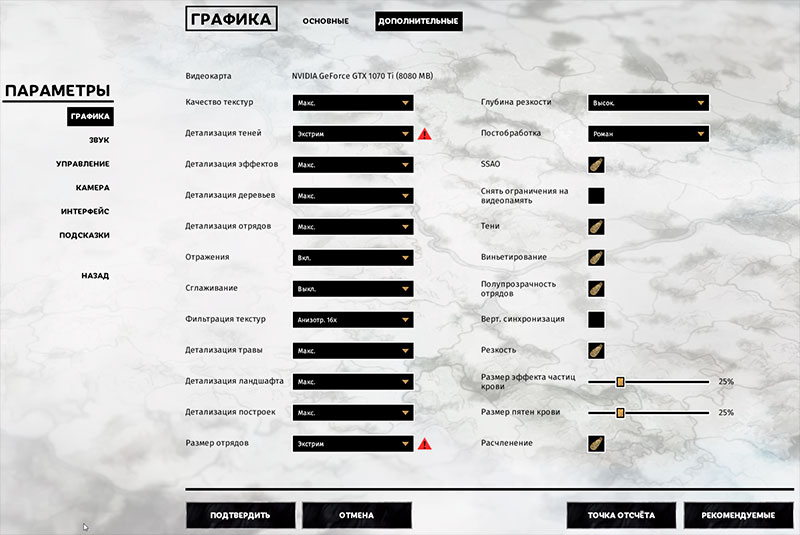
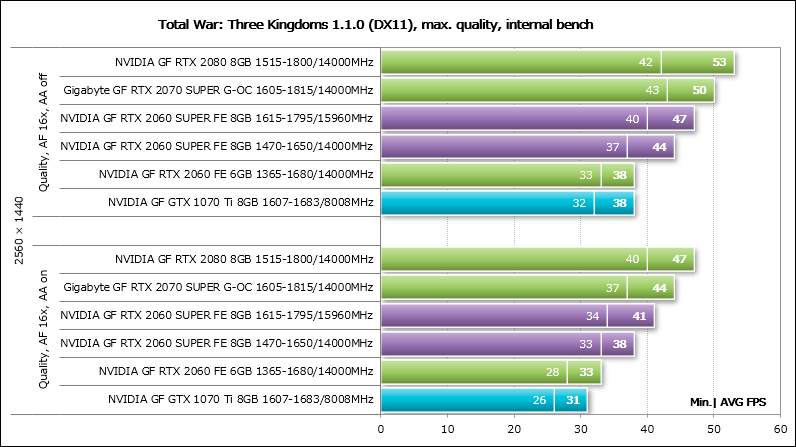
F1 2019
And in the new F1 2019 we will also present the graphics quality settings used for testing.
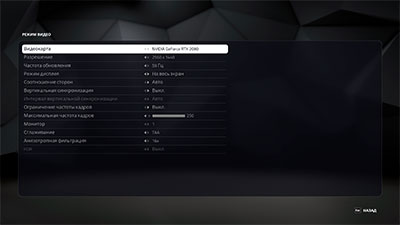
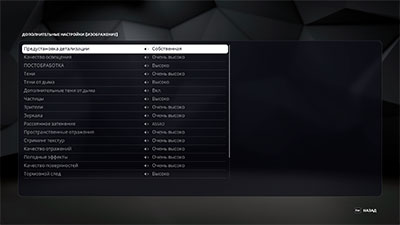
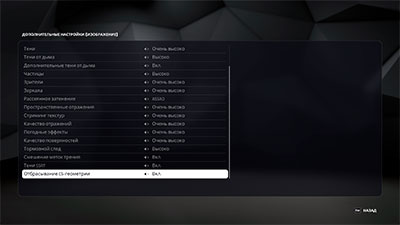
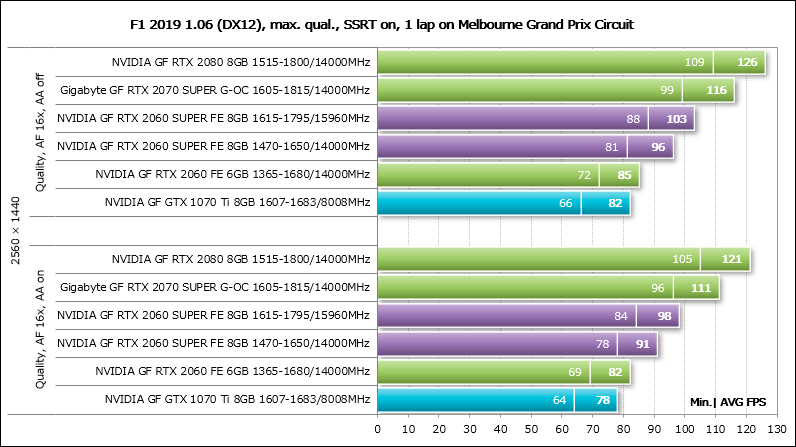
Let’s supplement the constructed diagrams with a summary table with test results with the displayed average and minimum value of the number of frames per second for each video card.
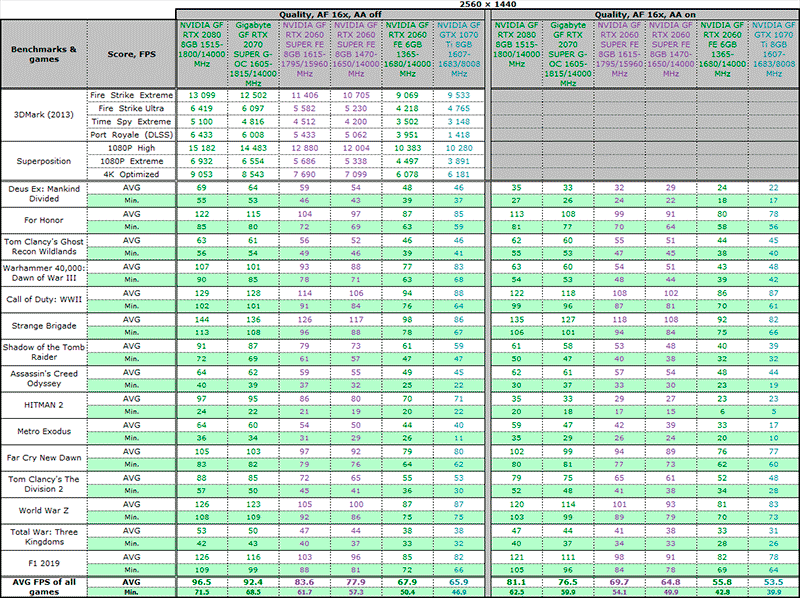
We will analyze the results using summary diagrams.
4. Summary charts and analysis of results
First of all, on the summary chart, we will analyze how the NVIDIA GeForce RTX 2060 SUPER is ahead of the regular NVIDIA GeForce RTX 2060, the results in the gaming tests of which are taken as the zero axis in the first summary chart.
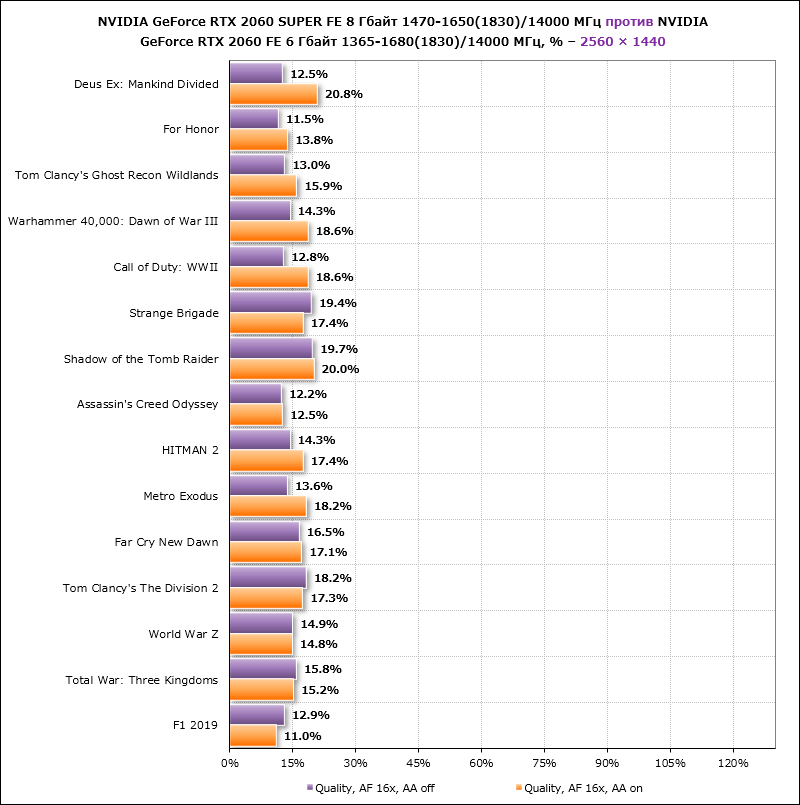
As you can see, we got a very good performance gain in all games. Its maximum value is 20.8% in the Deus Ex: Mankind Divided anti-aliasing mode, and the minimum is 11.0% in the new F1 2019. If we calculate the average value for all games, then in the non-anti-aliasing modes it is 14.8% , and when activated, it increases to 16.6%. An excellent result, it seems to us, especially since the new NVIDIA GeForce RTX 2060 SUPER was released without increasing the cost.
Next, let’s look at the difference in performance between NVIDIA GeForce RTX 2060 SUPER and the new GeForce RTX 2070 SUPER by Gigabyte. Recall that the frequencies of the original video card differ from the reference ones by only 45 MHz, therefore, by and large, we are comparing two reference video cards.
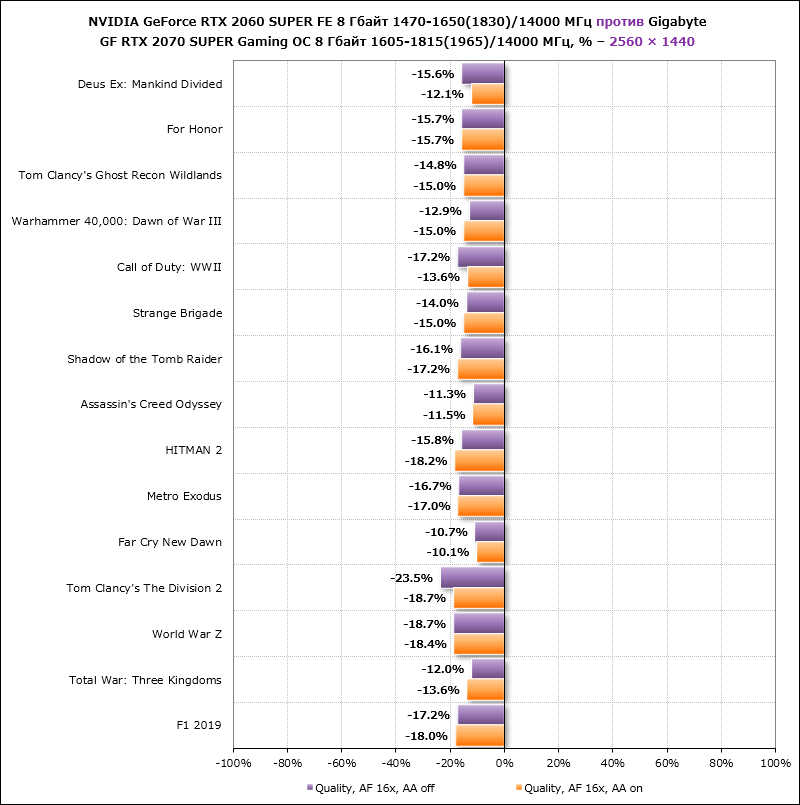
The lag behind the SUPER version of GeForce RTX 2060 from the next step in the new series of NVIDIA video cards is about the same as its advantage over the regular GeForce RTX 2060, and on average for all games is 15.5% in modes without anti-aliasing and 15.3% with activation of his various techniques.
Finally, we suggest evaluating the performance gain from overclocking the NVIDIA GeForce RTX 2060 SUPER. Recall that our graphics processor overclocked by almost 10%, and video memory – by 14%.
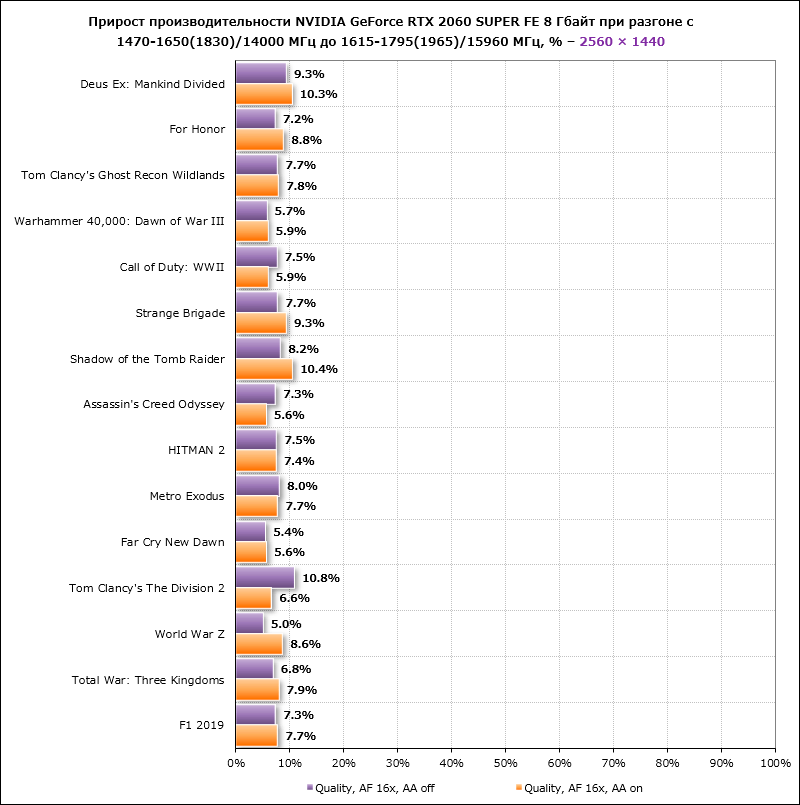
Such overclocking made it possible to speed up the video card in some games by up to 10-11%, and on average it was 7.4-7.7%. This makes it possible to compensate for the lag behind the GeForce RTX 2070 SUPER by about half. Considering the difference in price between these video cards, which currently reaches 30%, the new GeForce RTX 2060 SUPER with 8 GB of memory seems to us to be a more profitable purchase.
5. Computing performance
Today we will add a small block of tests in computations and ray tracing to testing in 3D benchmarks and games. First, there are four tests from the CompuBench 2.0 package.
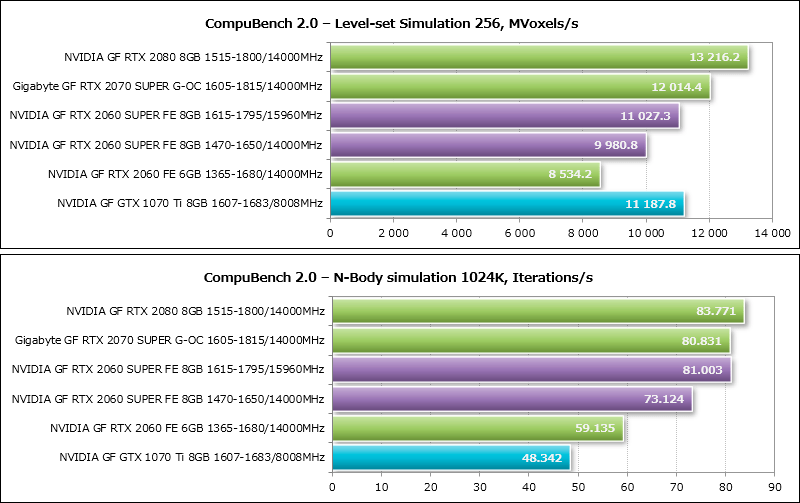
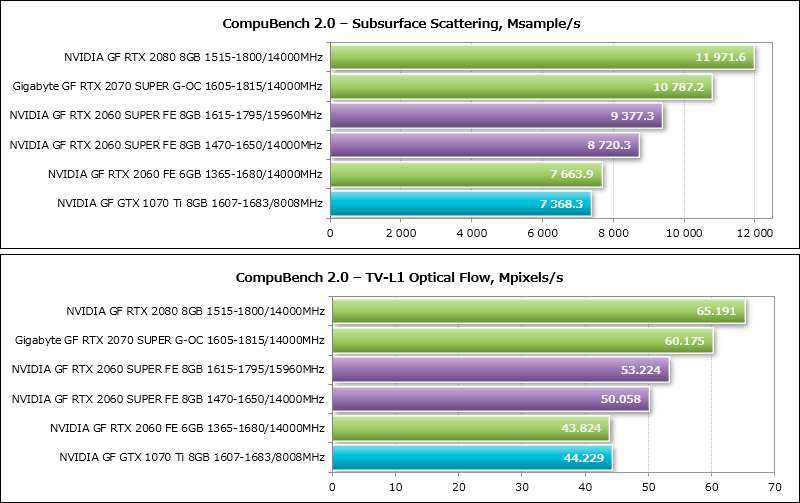
Compared to its predecessor, the NVIDIA GeForce RTX 2060 SUPER has greatly improved CompuBench 2.0 in all four tests, and looks even more convincing when overclocked. Nevertheless, only in one benchmark – N-Body simulation 1024K – it managed to reach the same level with the Gigabyte GeForce RTX 2070 SUPER Gaming OC, and in the Level-set Simulation 256 test it even lost a little to the nominal NVIDIA GeForce GTX 1070 Ti.
We can observe a similar alignment of forces in two tests from the AIDA64 utility.
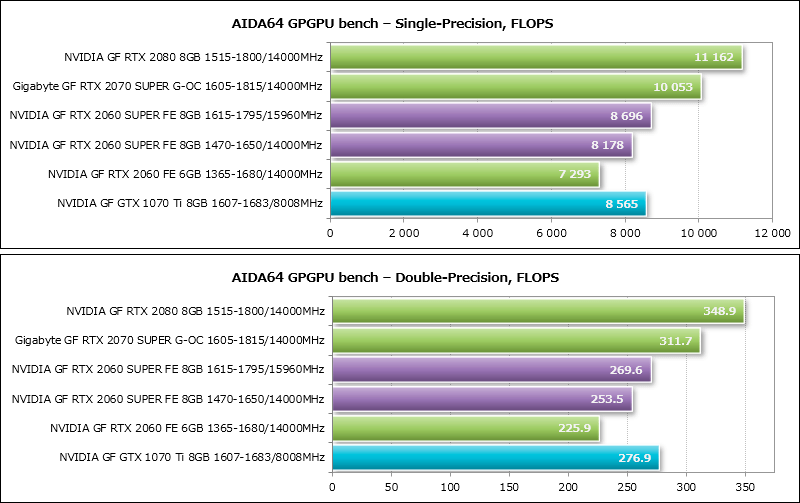
But in LuxMark 3.1 and especially in the RTX OctaneBench 2019, the old GeForce GTX 1070 Ti has no chance.
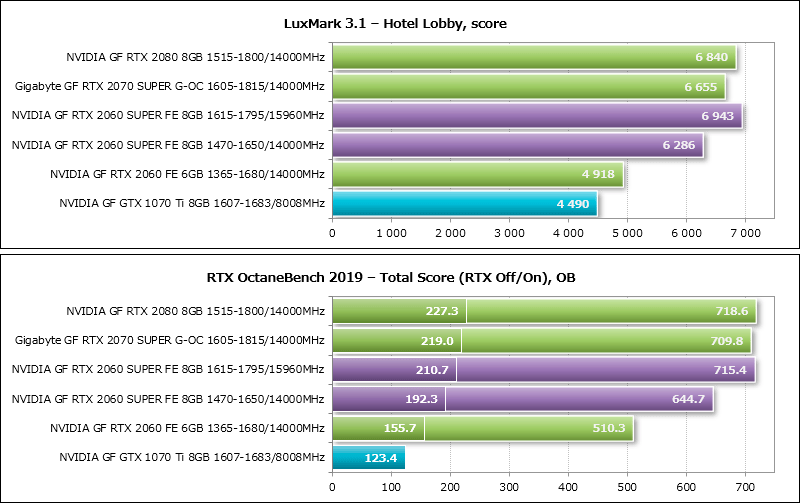
The ray tracing rendering in OctaneBench 2019 stands out, where the NVIDIA GeForce RTX 2060 SUPER not only seriously breaks away from the NVIDIA GeForce RTX 2060, but is also capable of reaching the same performance level with two older video cards during overclocking. Well, the result of NVIDIA GeForce GTX 1070 Ti in this test clearly demonstrates to us where video cards on the old architecture will be in new games with support for ray tracing in real time. By the way, there are more and more such games every month.
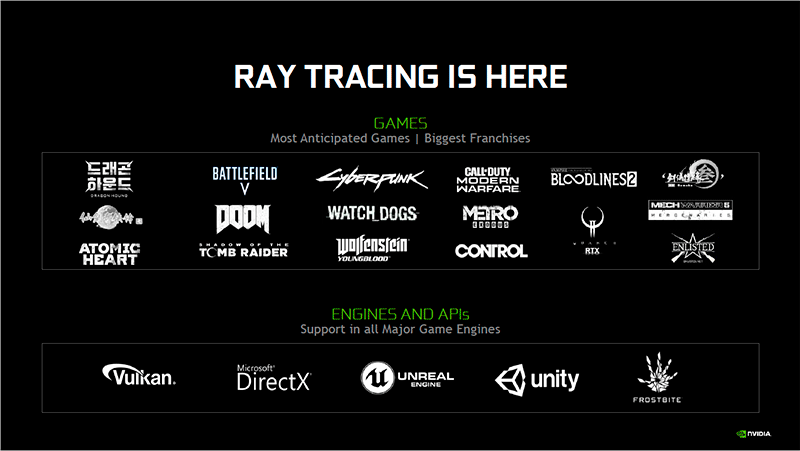
In addition to the traditionally strong position of NVIDIA in GPGPU and ray tracing, we note the possibility of serious acceleration of applications for CG content by new GPUs. In particular, the popular package for creating and editing video Adobe Premiere Pro CC claims 14x acceleration even in comparison with such a powerful processor as Intel Core i9-9900K.
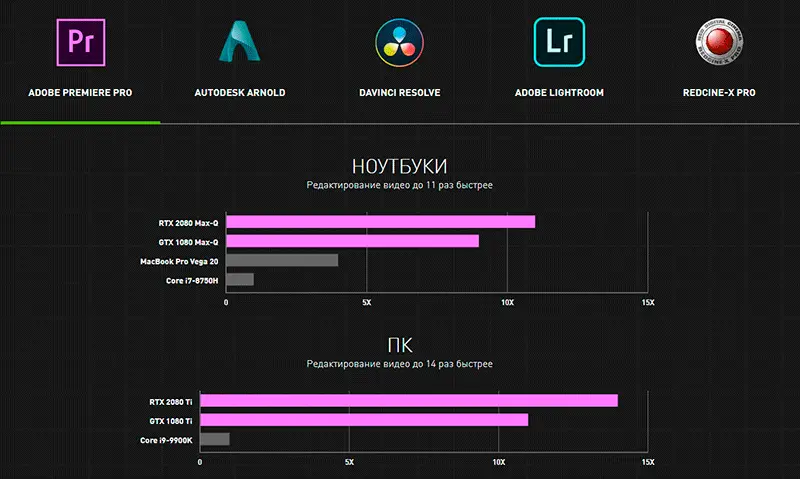
We will definitely return to this certainly interesting topic in a future article.
6. NVIDIA FrameView
Along with the new video cards, NVIDIA has introduced the FrameView utility designed to measure the performance and power consumption of video cards. The small and simple program supports all DirectX 9, 10, 11, 12, OpenGL, Vulkan and UWP (Universal Windows Platform) graphics APIs and does not affect readings during measurement capture.
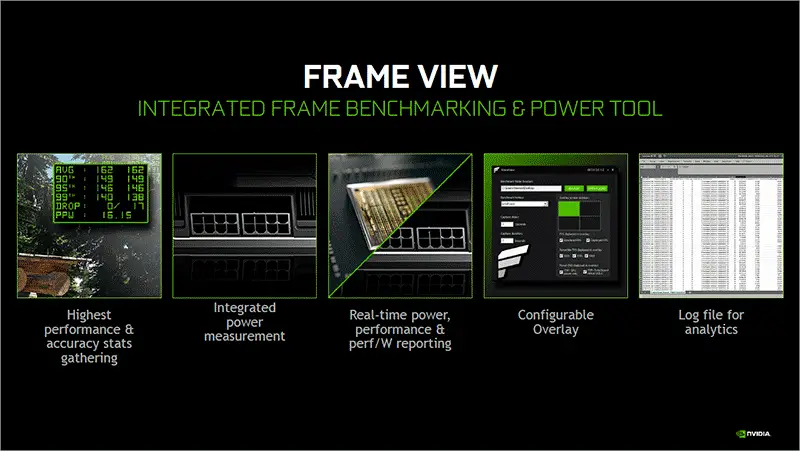
Unlike FRAPS and similar utilities, FrameView is capable of capturing frame rates at the 90th, 95th and 99th percentile.
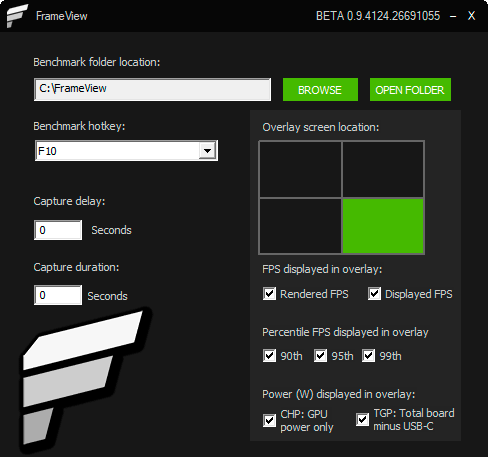
Still, its most important feature is the ability to monitor the power consumption level of video cards: separately for the GPU and the entire video card as a whole. The results are shown in real time in an overlay that can be placed in any corner of the screen.
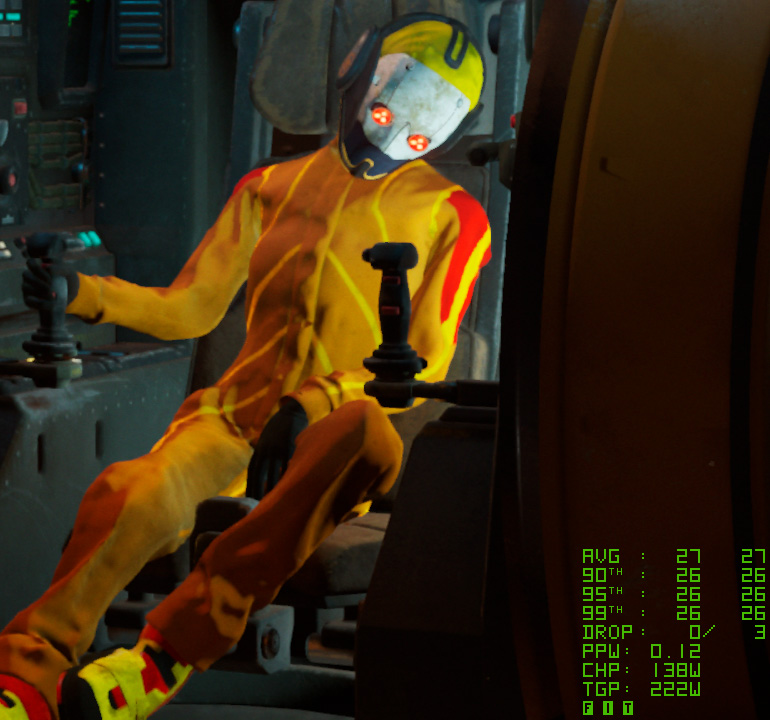
When they are written to the log file, the overlay is disabled. The results are saved in a predefined folder in CSV format, which can be easily opened with Excel and then analyzed at the user’s request.
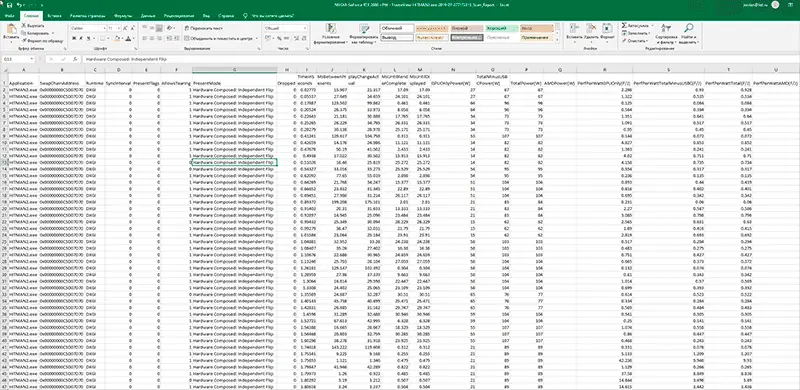
By the way, such an interesting parameter as PPW is saved in the log file – performance per watt, calculated as the ratio of performance to power consumption of the card (FPS / TGP).
7. Power consumption
In today’s article, we measured energy consumption in two ways. In the first, the energy consumption was measured using a Corsair AX1500i power supply via the HWiNFO64 interface . The energy consumption of the entire system as a whole was measured without taking into account the monitor. Testing was carried out in 2D mode with normal work in Microsoft Word or Internet surfing, as well as in 3D mode.
In the latter case, the load was created using two successive test cycles of the Call of Duty: WWII game according to our method in a resolution of 2560×1440 pixels with maximum graphics quality settings using anti-aliasing. CPU power saving technologies are disabled in the motherboard BIOS.
Let’s compare the level of power consumption of systems with the video cards tested today according to the results in the diagram.
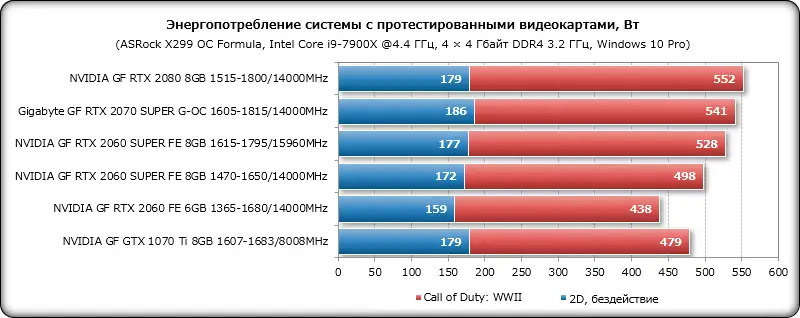
As you can see, the new NVIDIA GeForce RTX 2060 SUPER noticeably increased the level of power consumption – the system with it demonstrates a 60 watts higher level than the same configuration with a regular GeForce RTX 2060, and overclocking the video card increases the maximum power consumption level by another 30 watts.
At the same time, a system with a GeForce RTX 2070 SUPER still consumes a little more, but uncritically more. Any of the tested configurations fits well into 550 watts of power, not counting a system with a GeForce RTX 2080. Moreover, we use a ten-core processor overclocked with increasing voltage at a frequency of 4.4 GHz, which accounts for the lion’s share of the total power consumption.
In the second measurement method, we used a new FrameView, from the logs of which for each tested video card the minimum level of power consumption of the graphics processor (GPUOnlyPower (W)) and its maximum value, as well as the maximum value of the power consumption of the entire video card (TotalPower (W)) are displayed on the diagram.
For the load in this test, we used the HITMAN 2 game benchmark at 2560×1440 pixels with maximum graphics quality settings and anti-aliasing. Recall that on all video cards the power and temperature limits have been increased to the maximum possible, and let’s look at the results.
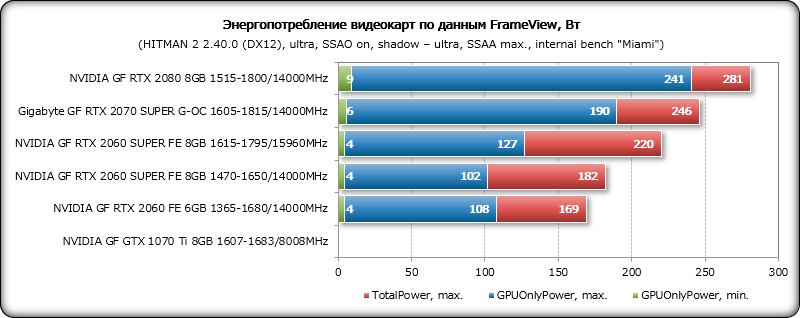
The utility also worked with the GeForce GTX 1070 Ti video card, but only the minimum power consumption values were recorded in the log file, so there are no results on the diagram. Let’s make allowances for the fact that FrameView is still in beta testing. As for the rest of the results, the overall picture with the first measurement technique has not changed, but now we can see what is the difference in the power consumption of graphics processors of video cards and how economical they are without 3D load. In addition, the GPU GeForce RTX 2060 SUPER showed a slightly higher result than the GPU GeForce RTX 2060, which is not logical, although in terms of the total power consumption of these video cards, everything falls into place. Note that the utility is very interesting and provides enough data for analysis. It would be great if FrameView could work correctly not only with NVIDIA graphics cards.
Outcomes
To date, we already know the test results of the NVIDIA GeForce RTX 2070 SUPER and GeForce RTX 2080 SUPER, so now we can confidently call the NVIDIA GeForce RTX 2060 SUPER Founders Edition the most successful of the updated models on the Turing architecture GPUs. It received a TU106 graphics processor with additionally unlocked streaming multiprocessors and an increased base frequency of the core by 105 MHz, as well as eight gigabytes of video memory on a 256-bit bus versus six on a 192-bit one.
All this allowed the new video card to outperform its predecessor by an average of 15-17%, and in some games its advantage reaches 21%. At the same time, NVIDIA GeForce RTX 2060 SUPER has become even more expressive in terms of design. But the most important thing is that with all the improvements listed above, the new video card is offered without an increase in cost, and the price of a regular GeForce RTX 2060 has been significantly reduced. As a result, just six months after the appearance of the GeForce RTX 2060, NVIDIA has seriously strengthened its position in this price segment and in the competition with AMD.
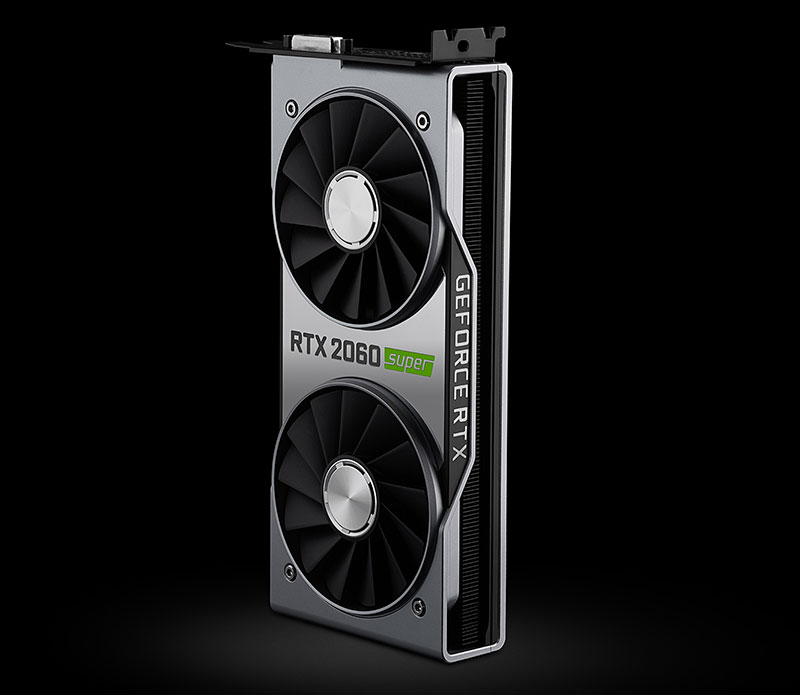
Choose video cards according to your taste – in our price list!





